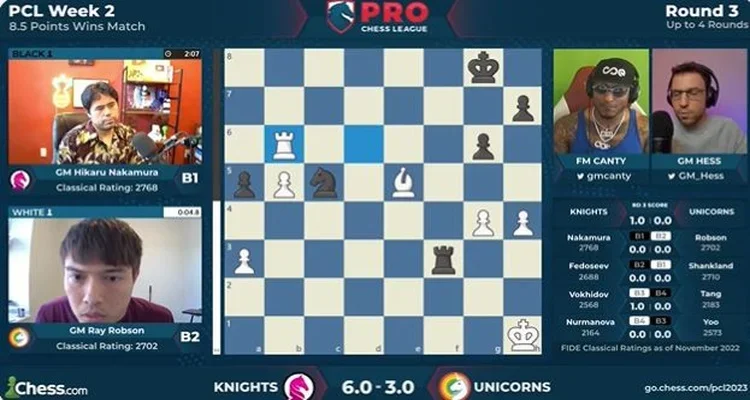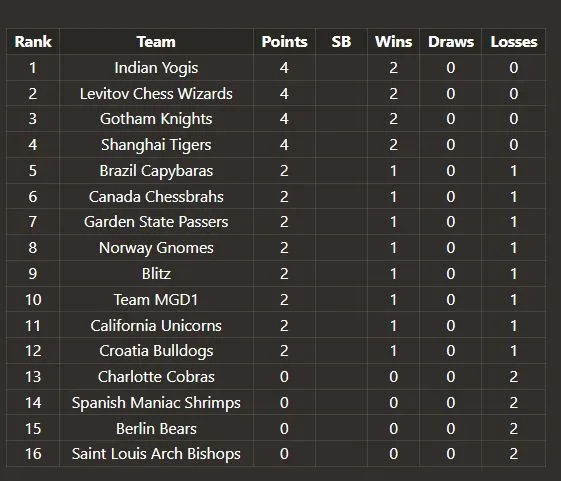Is classical chess dead? It’s no secret that this question makes me grimace. But it’s not because I am a “purist” who will balk at rapid chess. Rather, it is because such questions provoke a defensiveness on behalf of classical chess. This defensiveness, in turn, leads to dismissive attitudes towards rapid, particularly online rapid, chess.
“There are too many games to follow.” Sure, but you don't have to watch chess in real time to enjoy it. “Lots of games end in blunders or time scrambles.” Okay, is that any worse than quick draws? “Players play “joke” openings.” See previous answer. You name an excuse, and I’ve heard it. But I think this dismissiveness of rapid chess results in missing out on what I think are some of the most instructive contemporary games of chess played at any level.

Enter the new season of the Pro Chess League (PCL), hosted by Chess.com. The format, to nobody’s surprise, is a bit confusing: players don’t all need to live near their team’s host city, average ratings have loopholes and exceptions, etc. But the gist of the format is: teams of four players play all-play-all rapid matches that feature some of the best players in the world going up against each other.
More interestingly, we get opportunities to see some of these world class players show what makes them different than still-excellent lower-rated GMs, IMs, and up-and-coming FMs. We also get to see some of these younger, less established, players show off their stuff in front of a major audience. And with the condensed time controls, as well as the pressure of playing for a team, the result is a real opportunity to see how strong players’ intuitions differ from the world’s strongest players. And, of course, how these intuitions differ from our own. Which we can learn from.
So, rather than provide regular recaps of this season of the PCL, I’m going to highlight what I find to be the most instructional moments from the thought processes behind some of the games. But first, a brief overview of this season.

16 teams are competing this season, and there are plenty of options to root for with five American teams in the league. The makeup of each team can vary from week to week, but the Saint Louis Arch Bishops regularly feature GM Fabiano Caruana and rising FM Alice Lee. The California Unicorns boast GMs Sam Shankland and Ray Robson. But that’s just the beginning: we haven’t even mentioned the only American team on 2-0-0: GM Hikaru Nakamura’s Gotham Knights.
Additionally, it is hard to not love the Charlotte Cobras, featuring GMs Daniel Naroditsky, Grigoriy Oparin, Andrew Tang, and Chess Life favorite Elshan Moradiabadi. The Garden State Passers, with GMs Sam Sevian and Abhimanyu Mishra, are also not to be taken likely. Hey, even the Canada Chessbrahs offer WGM Jennifer Yu playing alongside the likes of GMs Magnus Carlsen and Anish Giri. Again, there is no shortage of options vying for your heart.
Now, let’s start with our first major upset of the season.
Board four WGM Josefine Heinemann takes down GM Hikaru Nakamura in the very first round!
— ProChessLeague (@ProChessLeague) February 16, 2023
Her smile at the end is priceless. 🥲#ProChess pic.twitter.com/iEbaQxelRU
Josefine Heinemann is a 25-year-old German WGM who plays board four for her home nation’s Berlin Bears. Here she is scoring the rare four-over-one upset over GM Hikaru Nakamura’s Knights.
Now, onto the teaching moments. The first set of games I want to focus on all feature on the stronger side launching an intuitive attack against an under-protected king. It’s worth reviewing these games to think about how the losing side ended up under such pressure, and what could have gone differently. In my comments, I try and focus on the logic guiding the attacking side’s moves.
While rapid chess thrives on intuition, there’s no shortcut for those moments where calculation is required. Here, I want to focus on a few positions that give us “clues” to look for that can help guide our calculation. Which lines are open? What patterns do you see? Which of our own weaknesses could generate counterplay for our opponent?
Finally, everybody loves a good endgame. Here, the main themes will be piece activity and counterplay. But don’t forget: there’s no rule that says you can’t be mated in the endgame, either.
Those looking for incredibly precise, accurate chess between super-GMs will have no shortage of classical chess to feast on in the coming months. I hear there’s even a match between the world’s second- and third-best players coming up in less than six weeks.
For now, I hope I have convinced you that it is possible to find joy, excitement, and even instruction in the mess that is tense, fast-paced rapid chess. The regular season continues for three more weeks, including this one, with three weeks of playoffs to follow.
Categories
Archives
- December 2025 (27)
- November 2025 (29)
- October 2025 (39)
- September 2025 (27)
- August 2025 (29)
- July 2025 (43)
- June 2025 (25)
- May 2025 (24)
- April 2025 (29)
- March 2025 (29)
- February 2025 (20)
- January 2025 (24)
- December 2024 (34)
- November 2024 (18)
- October 2024 (35)
- September 2024 (23)
- August 2024 (27)
- July 2024 (44)
- June 2024 (27)
- May 2024 (31)
- April 2024 (51)
- March 2024 (34)
- February 2024 (25)
- January 2024 (26)
- December 2023 (29)
- November 2023 (26)
- October 2023 (37)
- September 2023 (27)
- August 2023 (37)
- July 2023 (47)
- June 2023 (33)
- May 2023 (37)
- April 2023 (45)
- March 2023 (37)
- February 2023 (28)
- January 2023 (31)
- December 2022 (23)
- November 2022 (32)
- October 2022 (31)
- September 2022 (19)
- August 2022 (39)
- July 2022 (32)
- June 2022 (35)
- May 2022 (21)
- April 2022 (31)
- March 2022 (33)
- February 2022 (21)
- January 2022 (27)
- December 2021 (36)
- November 2021 (34)
- October 2021 (25)
- September 2021 (25)
- August 2021 (41)
- July 2021 (36)
- June 2021 (29)
- May 2021 (29)
- April 2021 (31)
- March 2021 (33)
- February 2021 (28)
- January 2021 (29)
- December 2020 (38)
- November 2020 (40)
- October 2020 (41)
- September 2020 (35)
- August 2020 (38)
- July 2020 (36)
- June 2020 (46)
- May 2020 (42)
- April 2020 (37)
- March 2020 (60)
- February 2020 (38)
- January 2020 (45)
- December 2019 (34)
- November 2019 (35)
- October 2019 (42)
- September 2019 (45)
- August 2019 (56)
- July 2019 (44)
- June 2019 (35)
- May 2019 (40)
- April 2019 (48)
- March 2019 (61)
- February 2019 (39)
- January 2019 (30)
- December 2018 (29)
- November 2018 (51)
- October 2018 (45)
- September 2018 (29)
- August 2018 (49)
- July 2018 (35)
- June 2018 (31)
- May 2018 (39)
- April 2018 (31)
- March 2018 (26)
- February 2018 (33)
- January 2018 (30)
- December 2017 (26)
- November 2017 (24)
- October 2017 (30)
- September 2017 (30)
- August 2017 (31)
- July 2017 (28)
- June 2017 (32)
- May 2017 (26)
- April 2017 (37)
- March 2017 (28)
- February 2017 (30)
- January 2017 (27)
- December 2016 (29)
- November 2016 (24)
- October 2016 (32)
- September 2016 (31)
- August 2016 (27)
- July 2016 (24)
- June 2016 (26)
- May 2016 (19)
- April 2016 (30)
- March 2016 (36)
- February 2016 (28)
- January 2016 (32)
- December 2015 (26)
- November 2015 (23)
- October 2015 (16)
- September 2015 (28)
- August 2015 (28)
- July 2015 (6)
- June 2015 (1)
- May 2015 (2)
- April 2015 (1)
- February 2015 (3)
- January 2015 (1)
- December 2014 (1)
- July 2010 (1)
- October 1991 (1)
- August 1989 (1)
- January 1988 (1)
- December 1983 (1)







